“This food should be held in storage for the land in preparation for the seven years of famine that will occur throughout the land of Egypt. In this way the land will survive the famine.”
Genesis 41:36 (NET)
“Food is simply sunlight in cold storage.”
John Harvey Kellogg
Discover the purpose of your work and align it with your corporation’s mission.
What is your purpose in work?
- To combat food waste and safeguard lives through effective cold chain logistics.
- Strive to establish industry-leading standards for cold chain storage in Borneo.
What drives your corporation’s core value?
- Capture new opportunities in selected emerging markets.
- To establish cold chain infrastructure that benefits local communities and provides access to its advantages.
Cold chain logistics
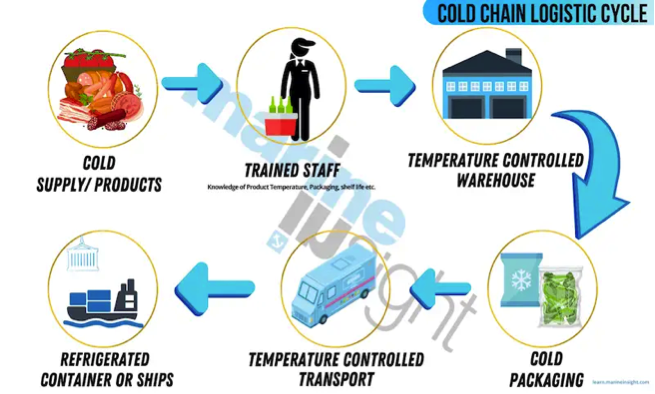
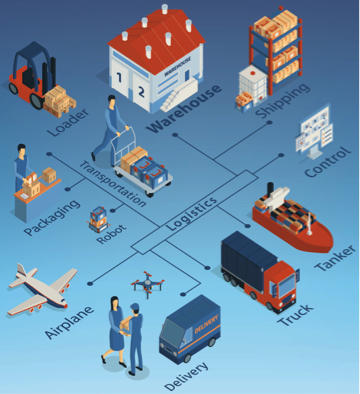
Source: Marine Insight Hari Menon 2021
Source: NLTF Malaysia 2021
1.0 Executive Summary
Mission:
- Hub: The mission is to transform Borneo into a leading cold chain logistics hub in the Asia Pacific region.
- Entity: Aim to establish strategic alliances with foreign investors, top international cold chain logistics operators, and target market companies.
- Segment: The goal is to set up six major cold chain hubs adjacent to the six new seaports.
Key Management Team:
- Mentors: Visionary pioneers and industry leaders with a global network who provide guidance and inspiration.
- Coaches: Mission-oriented industry experts offering practical solutions to keep the team focused on its objectives.
- Partners:
- A project leadership group with visionary goals.
- A reputable investment manager with global cold chain logistics funding sources.
- Target market groups, including supermarket, meat, seafood, fruits, vegetables, food, pharmaceuticals, industrial chemicals, and beverage companies.
- Credible local logistics operators with procurement capabilities, local networks, solid financial status, and government support.
Product Benefits:
- Reliable: Cold chain logistics ensure effective distribution of perishable products from origin to destination.
- Fresh: Reducing food waste and delivering fresh products.
- Quality: Maintaining quality control and supply chain integrity through proper cold storage and chain management.
Target Market:
- Segment: Six cold chain logistic hubs: Brunei, Sandakan, Lahad Datuk, Balikpapan, Banjarmasin, Kijing.
- Target: Key international supermarket, meat, seafood, fruits, vegetables, food, pharmaceuticals, industrial chemicals, and beverage companies.
Financial Projections:
- Investment: US$600 million
- Cost: US$25.98 million/year
- Revenue: US$209.088 million/year
- Income: US$183.108 million/year
- Payback: 4 years (80% occupancy rates)

Unique Business Model:
- Team: Leveraging a fully integrated vertical and horizontal business model to maximize team member specialization.
- Target: Building revenue and a base platform through customer participation.
- Entry: Rapid market penetration through acquisition or merger with existing local cold storage companies.
- Partners: Expanding market shares in the target segment by integrating with existing importers, exporters, and distributors specializing in food, fisheries, fruits, vegetables, meat, pharmaceuticals, and chemical products.
2.0 Mission
2.1 Problem
- Borneo: Faces a shortage of cold chain logistics infrastructure, including power supply, storage, transportation, and processing facilities.
- APAC: The Asia Pacific region lacks uniform standards, foreign investments, and cold chain expertise to meet the growing demand for quality perishable goods.
- Wastage: Widespread food waste and insufficient cold chain infrastructure are prevalent issues in Asia.
Wastage in Asia
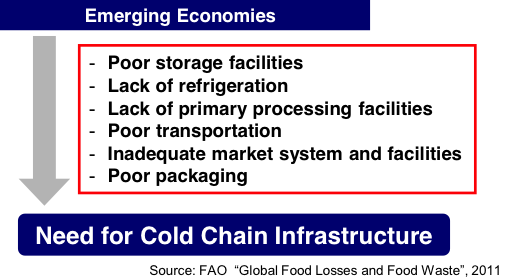
2.2 Solution
- Investment: Collaborate to reduce food waste, cut costs, and improve cold chain efficiency globally.
- Network: Invest in comprehensive cold chain logistics infrastructure, including transportation networks.
2.3 Mission
- Hub: Transform Borneo into a major international cold chain hub in Asia Pacific.
- Entity: Form alliances with top global cold storage logistics operators, private equity firms, and local logistics groups.
- Stage 1: Establish six cold storage hubs, each with 1.32 million pallets’ capacity, near new seaports and SEZs.
Six new cold chain logistics at the six new ports
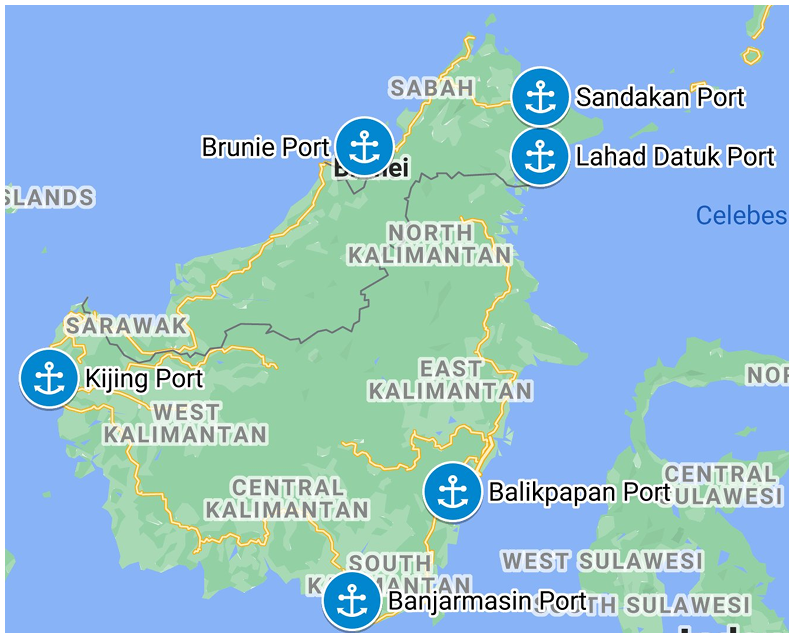
3.0 Product
3.1 Product Description
Scope: Cold chain logistics encompasses the transport and storage of perishable goods, such as meat, seafood, fruits, vegetables, pharmaceuticals, industrial chemicals, food, and beverages. It involves precise temperature control throughout storage and transportation.
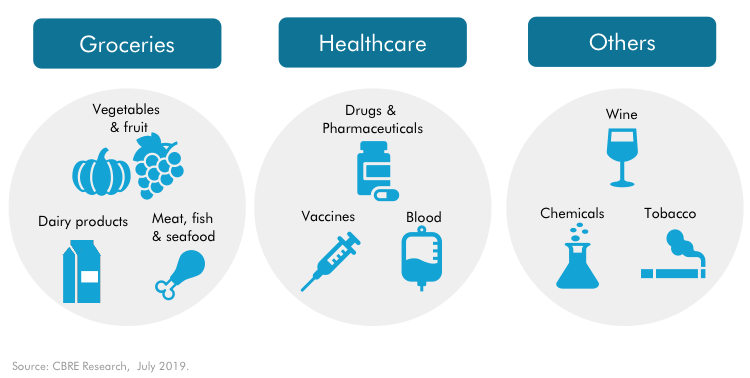
3.2 Product Attributes
- Carrier: Utilizes refrigerated trucks, railcars, cargo ships, and reefers.
- Specialty: Incorporates scientific technology and processes, including chemical and biological sciences, in managing perishable goods.
- Scope: Encompasses cooling systems, cold storage facilities, cold transport, cold processing, and distribution.
- Global: Influences global distribution of food, vaccines, chemicals, and pharmaceutical products to world markets.
- Regional: Supports regional interaction and integration through infrastructure.
- Local: Enables efficient local distribution to supermarkets, restaurants, and food stores.
- Standard: Adheres to industry standards like “banana” (13°C), “chill” (2°C), “frozen” (-18°C), and “deep-frozen” (-29°C).
3.3 Product Benefits
- Reliable: Ensures effective distribution of perishable products from their origins to final destinations.
- Fresh: Reduces food waste and delivers fresh products.
- Quality: Enhances quality control and preserves supply chain integrity through proper cold storage and chain management.
3.4 Product Competitive Advantages
- Integration: A horizontally and vertically integrated cold chain logistics system enhances reliability, timely distribution, and cost-efficiency.
- High-tech: Utilizes a digital platform, modern technology, and a fully integrated system to provide high-standard storage and management.
4.0 Market
4.1 Market Segment
- Partners: Form an entity with international cold chain logistics developers, investors, operators, and financiers.
- Product: Concentrate on end-products, including fruits, vegetables, dairy, meat, seafood, pharmaceuticals, chemicals, and industrial goods.
- Market: Target the Asia-Pacific (APAC) regions experiencing rapid growth in middle-income populations.
Market segments for investors
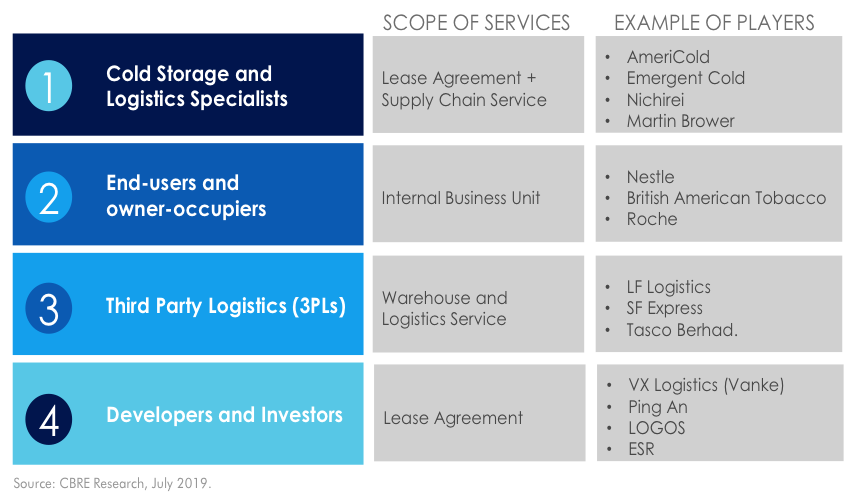
4.2 Target Market Strategy
- Stage 1: Initial focus on establishing cold chain logistics in Borneo to cater to the domestic seafood and agricultural consumption needs of over 250 million people.
- Stage 2: Expand regionally by collaborating with Asia-Pacific cold chain logistics groups, with a focus on exporting and importing goods for the APAC market.
- Stage 3: Pursue global expansion in collaboration with international cold storage groups.
4.3 Market Needs
- Indonesia Cold Storage Situation: Demand and supply in the cold storage industry align with industry needs.
- New Fish Farms and Agriculture: Investments in Borneo are expected to generate a demand for cold storage capacity exceeding 1 million metric tons.
Cold storage–demand and supply Industry needs
Cold storage–demand and supply
Industry needs


Source: BKPM – EU Desk at BKPM 2018
4.4 Growth Drivers
- Fresh: Key growth drivers include the proliferation of supermarkets, food stores, consumer preferences for fresh food, and the rise in international food trade.
- Demand: The increasing middle-income population in the Asia-Pacific markets drives growth in the consumption of fresh food, protein, seafood, tropical fruits, and vegetables.
- APAC: High demand in Asia-Pacific nations for overseas imports, particularly pharmaceuticals, medicine, chemicals, and industrial products.
- Online: The surge in e-commerce due to the COVID-19 pandemic fuels growth in the e-commerce cold chain industry.
4.5 Key Customers
Strategic alliance operators
China:
- Alibaba
- Beijing Er Shang Group
- China Merchants Americold Logistics
- Chengdu Silverplow Low-temperature Logistics
- CJ Rokin Logistics
- ESR
- Gaishi International Logistics
- HNA Cold Chain
- Hunan Hongxing Frozen Food
- JD
- Kangxin Logistics (Tianjin)
- Liaoning Dalian Ocean Fishery Group
- Logos
- METCOLD Supply Network
- MHL Logistics
- Ocean Star Aquatic Products
- SF Express
- Shanghai Jin Jiang International
- Shanghai Guangming
- Shanghai Xintiantian Dazhong Cold Logistics
- Shenyang Nonstaple Food Group
- Shenzhen Vanke Logistics
- Sinotrans
- Swire Cold Chain Logistics
- Tianjin Fisheries Group
- Xianyi Holding
- Zhengming Modern Logistics
- ZM Logistics
Japan:
- C & F Logistics Holdings
- Itochu Logistics
- Kintetsu World Express
- Kokubu
- K.R.S. Corp
- Kyuso
- Maruha Michiro Logistics
- Nichirei Corporation
- Senko
- Sojitz
- Yamato Holdings
- Yokohama Reito
- Yusen Logistics
Hong Kong:
- Brilliant Cold Storage Management
- Chevalier Cold Storage and Logistics
- Daido Group
- Dairy Farmer
- Hong Kong Ice & Cold Storage
- Kerry Logistics
- Nestle (HK)
- Park’N Shop
- Sun Wah Cold Storage
Korea:
- Boolim Pharmaceuticals
- Borim Logistics
- CJ Logistics
- Coupang
- Daelim Corporation
- DB Schenker
- Dongbu Express
- Hwaseong Dongtan Logistics Complex
- Dongwon Industrial
- GS Global
- Hansol Logistics
- Kendall Square Bucheon Cold Chain Park
- Korea Superfreeze
- Lotte Logistics
- Ottogi Logistics
- Pantos Logistics
- Yongin Logistics Center
Singapore:
- Bolloré Logistics
- CEVA Logistics
- Cold Storage Group
- CWT
- DB Schenker
- DHL Global Forwarding
- Dnata Coolchain
- DSV Air & Sea Singapore
- Emerson SG
- Global Alliance Logistics
- Jurong Cold Store
- Keppel Logistics
- Kuehne+Nagel Group
- Mandai Link Logistics
- Naigai Nitto Singapore
- Pan Ocean
- SATS Coolport
- Shinyuu Cold Chain
- Tee Yih Jia Food Manufacturing
- Thrucool
- Trust-Link
- YCH Group
- Yusen Logistics Singapore
- UPS
Malaysia:
- Aeon
- Angliss
- CKT Marketing
- Cold Storage
- Giant
- Hai Seng Yek Frozen Food
- IGLO Malaysia
- Integrated Cold Chain Logistics
- KFC
- Nestlé
- SK Cold Chain Solutions
- TASCO Yusen Gold Cold
- World Frozen
Indonesia:
- Adib Cold Logistics
- ALFI
- ASPERINDO
- Bonekom Servistama Compindo (BOSCO)
- Cold Storage Indonesia
- Dharma Samudera
- Diamond Cold Storage
- Dua Putera Perkasa
- DUNEX
- Fishing Industries
- Enseval Medika Prima
- GAC Samudera
- Gunung Sewu Group
- Indoguna
- Indomaguro Tunas Unggul
- Jalur Sejuk
- Kawanishi Warehouse Indonesia
- Kiat Ananda Cold Storage
- Lion Super Indo
- Maersk Line
- Mega International Sejahtera
- MGM Bosco
- Muda Cool
- Savina Cold Storage
- Sukanda Djaya
- Suri Nusantara Jay
- Unilever Indonesia
- Wahana Cold Storage
- Yusen Logistics Indonesia
4.6 Competition and Industry
In the 2018 Jakarta metropolitan area:
- There were 69 major cold chain companies with a combined capacity of 370,000 metric tons.
- Additionally, there were 27 cold chain rental companies with a total capacity of 210,000 metric tons.

Global top refrigerated warehousing and logistics
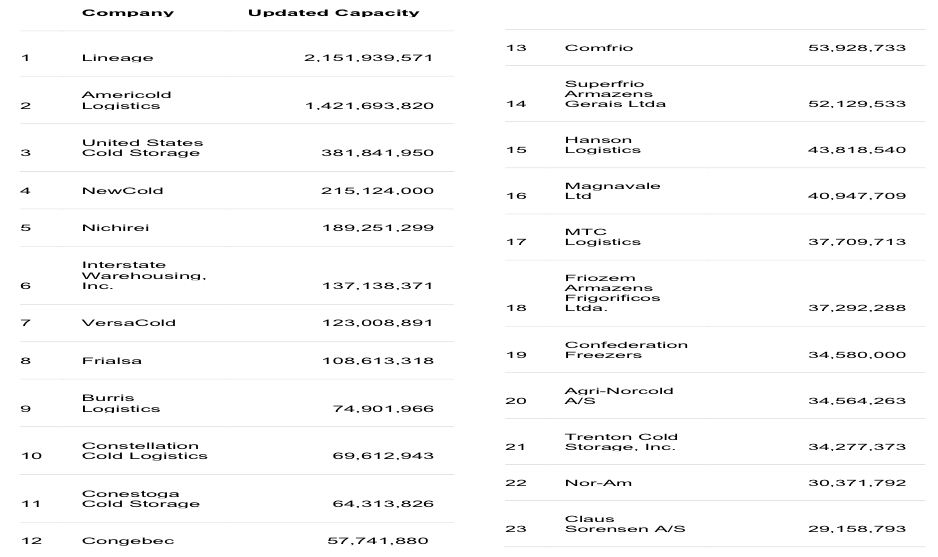
Source: Global Cold Chain Alliance 2021
5.0 Operation
5.1 Operation – Temperature control
Temperature monitoring is important for cold chain logistics.
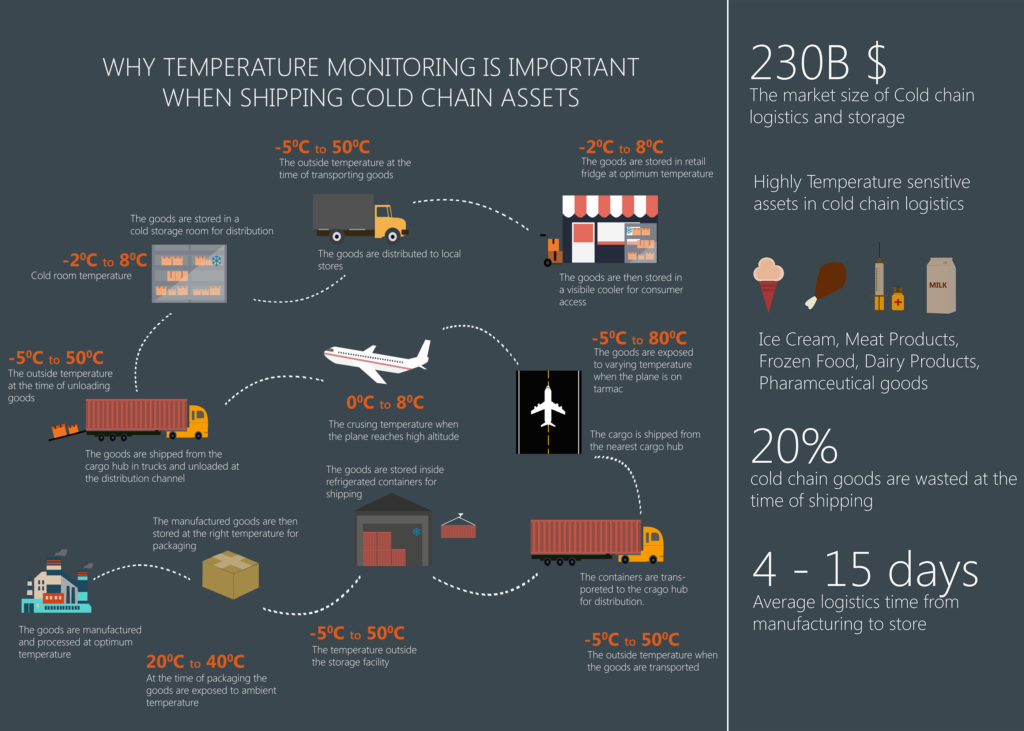
5.2 Operation–cold chain logistics
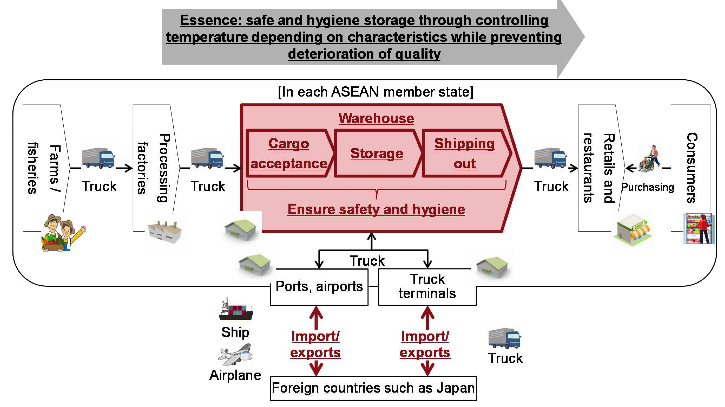
5.3 Operation–Reefer container terminal and power plugin
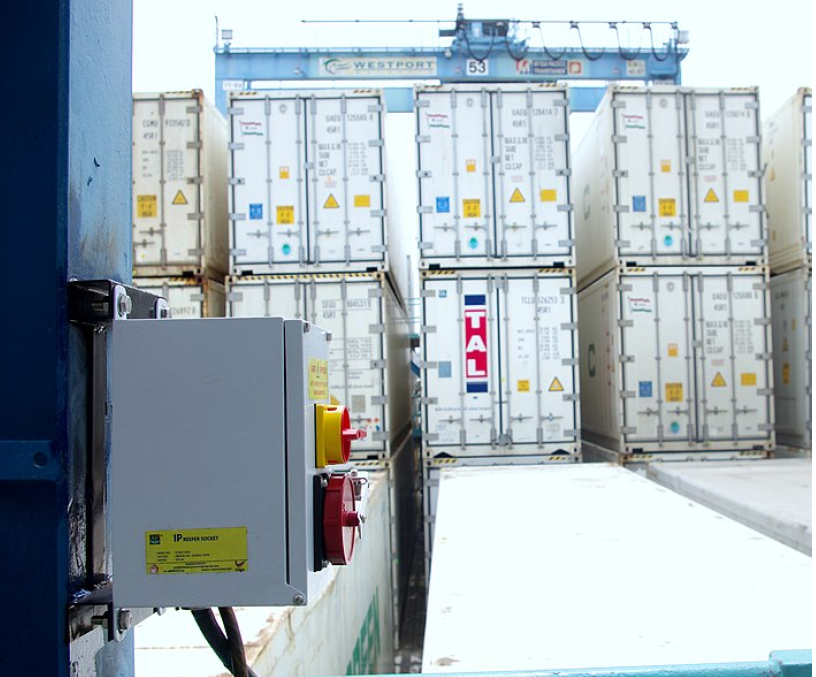
5.4 Operation–installations in cold storage facilities
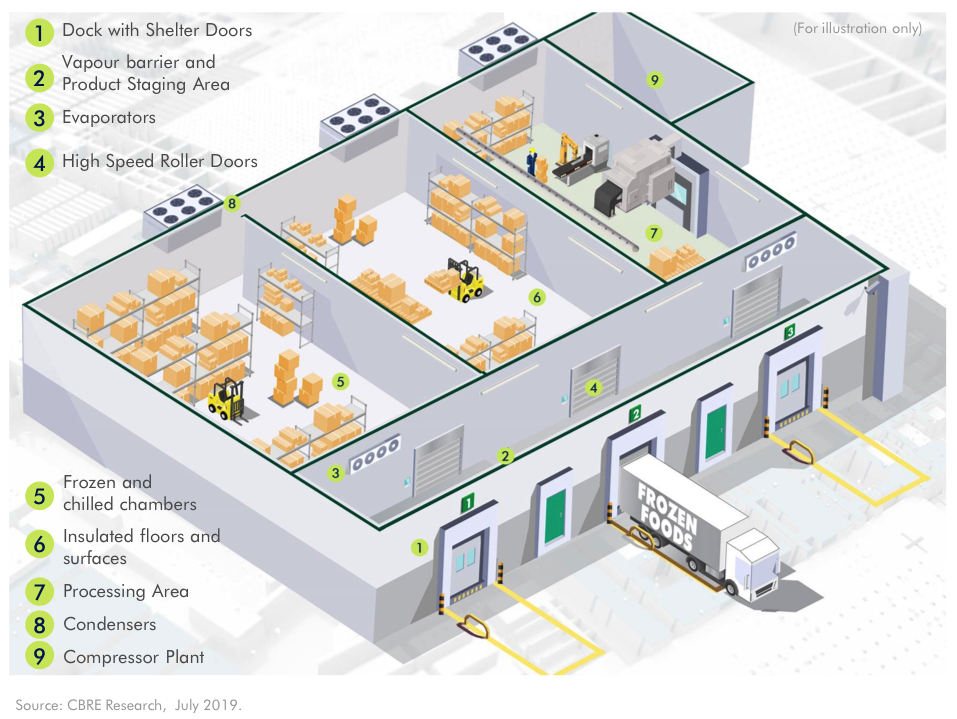
6.0 Financial Implications
6.1 Investment Segment
Phase 1: Six Cold Chain Hubs
Locations:
- Brunei
- Sandakan
- Lahad Datu
- Balikpapan
- Banjarmasin
- Kijing
Each Cold Chain Facility:
- Cold Storage: 18,000 square meters = 100,000 pellets, with 15 docks
- Chilled Storage: 24,000 square meters = 110,000 pellets, with 30 docks
- Container Yard: 700 TEU
Investment:
• Each Cold Chain Hub: 42,000 square meters X US$2,380/m2 = US$100 million • Total Investment for 6 Hubs: US$100 million X 6 hubs = US$600 million
Case Studies
Case Study 1: Port of Nansha, China (2021)
- Capacity: 460,000 metric tons
- Investment: US$500 million
- Phase 1: 305,000 square meters
- Phase 1 Capacity: 227,000 metric tons
- Phase 1 Cost: US$260 million
- Storage Yard: Cold storage containers yard with 430 TEU and 1,880 cold-plug slots.
Case Study 2: Lineage’s Acquisition of Emergent Cold, Australia (2020)
- Capacity: Australia – 30 temperature-controlled warehouses with 3.4 million cubic meters of storage and capacity for over 522,000 storage pellets, and 46 cold stores in six countries.
- Investment: US$0.95 billion
Case Study 3: Blackstone Investments at Lytton Street, Qld, Australia (2018)
- Capacity: 14,479 square meters
- Investment: US$40 million
Case Study 4: NewCold Advanced Cold Logistics Facilities, Australia (2018)
- Area: 42,000 square meters
- Investment: US$100 million
- Pellets: 220,000
Case Study 5: K.R.S.’s Acquisition of Kiat Ananda Cold Storage, Indonesia
- Capacity: 30,000 tons
- Building Area: 16,000 square meters
- Acquisition: Four companies
- Investment: US$62 million
Case Study 6: Kawanishi Warehouse, Indonesia (2017)
- Capacity: 5,600 square meters
- Investment: US$17.7 million
- Load Dock: 15
- Pallets: 5,500
Case Study 7: Kawanishi Warehouse Phase 2, Indonesia (2019)
- Capacity: 7,900 square meters
- Investment: US$26.3 million
- Load Dock: 16
- Pellets: 18,100
Case Study 8: Investment per Square Meter, Australia (2016-2018)
- Transaction prices ranged between US$1,266 to US$3,221 per square meter.
6.2 Production Cost for Malaysia
- Electricity Cost:
- Calculation: (250 kWh/m2/year / 12 months) X (42,000 m2) X (US$0.12) X (12 months) = US$1,260,000/year
- Natural Gas Cost:
- Calculation: (92,000 Btu/m2/year) X (42,000 m2) X (US$8.61/1,000,000) = US$33,269/year
- Energy Cost: 30% of total expenditure = US$1.30 million
- Labour: 30% of total expenditure = US$1.30 million
- Others: 40% of total expenditure = US$1.73 million
Estimated Production Cost per Cold Chain Facility: US$4.33 million/year Total for 6 Facilities = US$4.33 million X 6 hubs = US$25.98 million/year
Case Studies
1. 2021 Malaysia cold storage worker
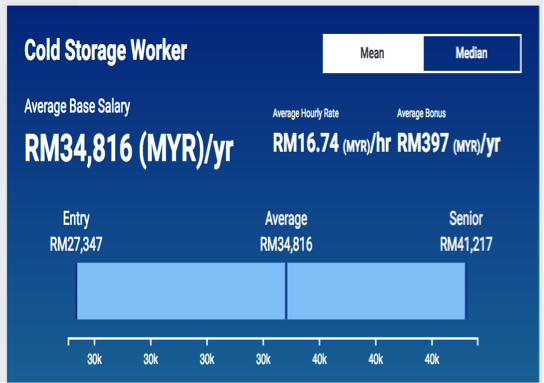
2. Production Cost Estimates for the USA:
- Lease Warehouse:
- Range: US$40-70/m2/month
- Operation (utilities, insurance, taxes):
- Range: US$20-US$30/m2/month
- Forklift Lease:
- Range: US$750-US$1,000/truck/month
- Labour Cost:
- Range: US$30-US$40/hour
2019 North America cost share

6.3 Price and Revenue Calculation:
Rental Revenue per Cold Storage Hub:
- US$16.50/m2 X 220,000 pellets X 80% occupancy X 12 months = US$34.848 million/year
Total Rental Revenue for 6 Cold Storage Hubs:
- US$34.848 million X 6 cold storage hubs = US$209.088 million/year
The estimated rental revenue for all 6 cold storage hubs amounts to US$209.088 million per year.
Malaysia:
- Cold Storage Warehouse Rental: US$16.51/m2/month (Facilities without operation cost)
Indonesia (2018) – Rental Income:
- Storage Cost: US$0.87/pallet/day (1m x 1.2m x 1m)
- Handling In: US$2.7/pallet
- Handling Out (loose): US$4/pallet
- Plug-In: US$3.3/hour
- Overtime: US$13.5/hour
Indonesia (2018) – Refrigerated Reefer Container:
- 20 Feet: US$404/unit/month
- 40 Feet: US$538/unit/month
- Purchase (20 Feet): US$6,100/reefer container
- Purchase (40 Feet): US$7,200/reefer container
Indonesia (2018) – Refrigerated Truck:
- Price Range: US$17,000 – US$37,000 for new refrigerated trucks
China:
- Cold Storage Warehouse Rentals: About US$16.50 – 18.37/m2/month
Singapore:
- Cold Storage Warehouse Rental: US$18.25- US$25.55/m2/month
Korea:
- Cold Storage Warehouse Rental: US$14 – US$21/m2/month
Hong Kong:
- Cold Storage Warehouse Rental: US$19.20 – US$25.60/m2/month
6.4 Financial Returns

Financial return
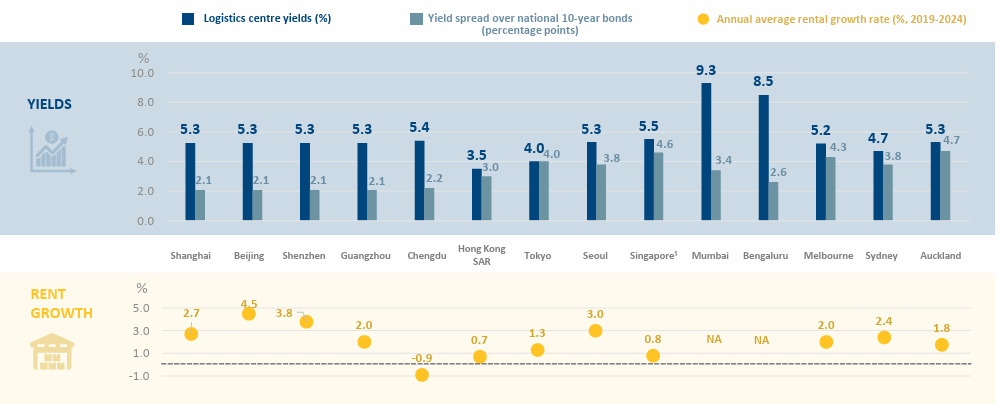
Source: Colliers International. Andrew Haskins, CK Lau, 2020
2019 Financial Income of listed cold storage logistics companies.
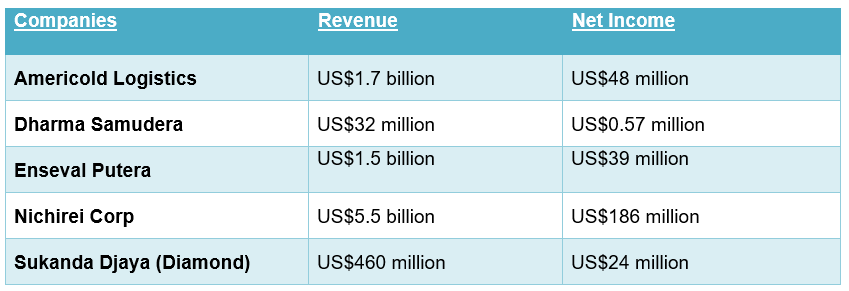
6.5 Source of Funding:
1. Strategic Investors:
- New Investor: Project leader with a focus on business and financial management.
- Financier: Private equity and investor groups specializing in cold chain logistics.
- Cold Chain Logistics: International and local cold chain logistics groups.
- Target Market: Key international supermarket, meat, seafood, fruits, vegetables, food, pharmaceuticals, industrial chemicals, and beverage companies.
2. Private Equities and Investors
- Aberdeen Standard Investments
- Adani
- AEW Capital Management
- Americold Realty Trust
- Amundi Asset Management
- Anderson Group
- Angelo Gordon
- APG Asset Management
- Apollo Infrastructure
- Asset Management One
- Bain Capital
- Bay Grove
- BentallGreenOak
- Black Creek Group
- BlackRock
- Blackstone
- Broadstone Real Estate
- Brookfield Asset Management
- CalPERS
- Capital Partners
- Capital Research & Management
- CBRE Global Investors
- CenterSquare Investment Management
- Charter Hall
- China Resources
- CIM Group
- CITIC
- Cohen & Steers
- Cold Storage Japan
- Conversant Capital
- D1 Capital Partners
- Daiwa Asset Management
- Dexus
- Dimensional Fund Advisors
- DWS Asset Management
- EMP Belstar
- EQT Exeter Property group
- ESR Kendall Square Asset Management
- Everett Harris
- GIC
- Geodis
- GLP
- Goldman Sachs Asset Management
- Goodman Group
- Hines
- HSBC Life
- Hudson Global Development Fund
- Ivanhoé Cambridge
- KingSett Capital
- KKR
- LCN Capital
- Mapletree Investments
- Mastern Investment
- Mitsubishi UFJ Financial Group
- Mizuho Financial Group
- Morgan Stanley Tactical Value
- Nikko Asset Management
- Nisshin Seifun Group
- Norges Bank Investment Management
- Nomura Asset Management
- Nuveen
- Oaktree Capital Management
- Oxford Properties
- PGGM Vermogensbeheer
- Prologis
- Schroder Investment Management
- SilkRoad Property Partners
- SSgA Funds Management
- Stonepeak Partners
- Sumitomo Mitsui Trust Asset Management
- Temasek
- Tricor Pacific Capital
- T. Rowe Price
- UBS Asset Management
- Vanguard Group
- Warburg Pincus
- Wellington Management
- Westcore
- Westport Capital Partners
- William Blair Investment Management
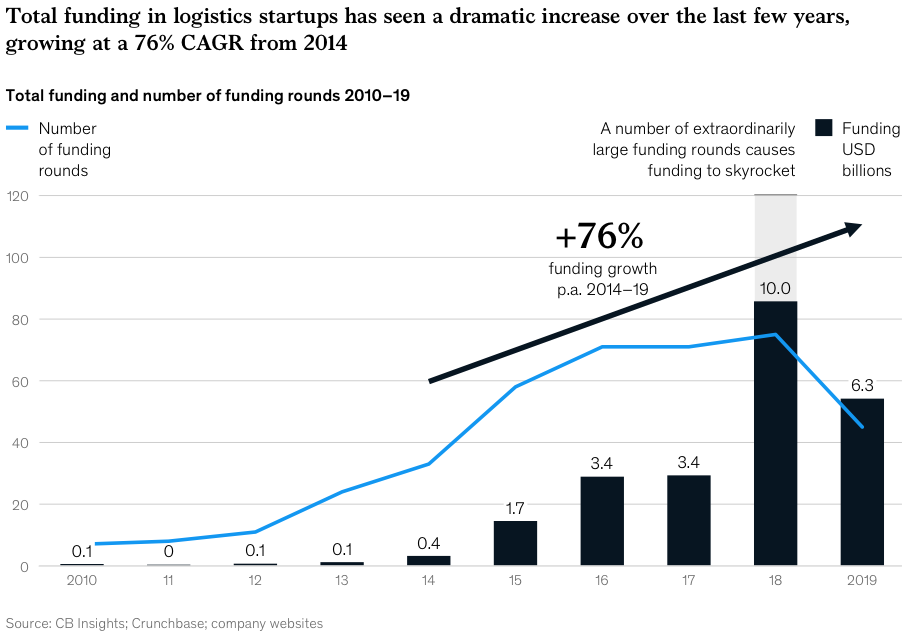
3. Consultants, development and fund managers to the cold storage logistics industry
- Asosiasi Rantai Pendingin Indonesia (ARPI)
- BCG (Boston Consulting Group)
- Capricorn Indonesia Consult
- CBRE (CB Richard Ellis)
- Colliers International
- Controlled Environment Building Association (CEBA)
- IFC (International Finance Corporation)
- International Association of Refrigerated Warehouses (IARW)
- International Refrigerated Transportation Association (IRTA)
- International Society of Logistics (SOLE)
- International Warehouse Logistics Associations (IWLA)
- KPMG
- Logistics Bureau
- McKinsey
- PWC (PricewaterhouseCoopers)
- Savills
- Taiwan International Logistics & Supply Chain
- YCP Solidiance
- World Food Logistics Organization (WFLO)
6.6 The Big Picture
- Rate: Shipping costs from China to the United States surged above US$20,000 per 40-foot container in 2021.
- Accident: The stranded ship blocking the Suez Canal caused a backlog of 450 ships and held up US$9.6 billion of trade each day.
- COVID-19: The rapid deployment of vaccines made a crucial difference in saving lives during the pandemic.
- War: The logistics planning for D-day on June 6th, 1944, involved moving 6,939 vessels, 156,000 soldiers, 195,700 naval personnel, and 11,590 aircraft during a risky 24-hour window in stormy weather.
Operation overlord
Suez Canal blockage
COVID-19 Vaccine logistics

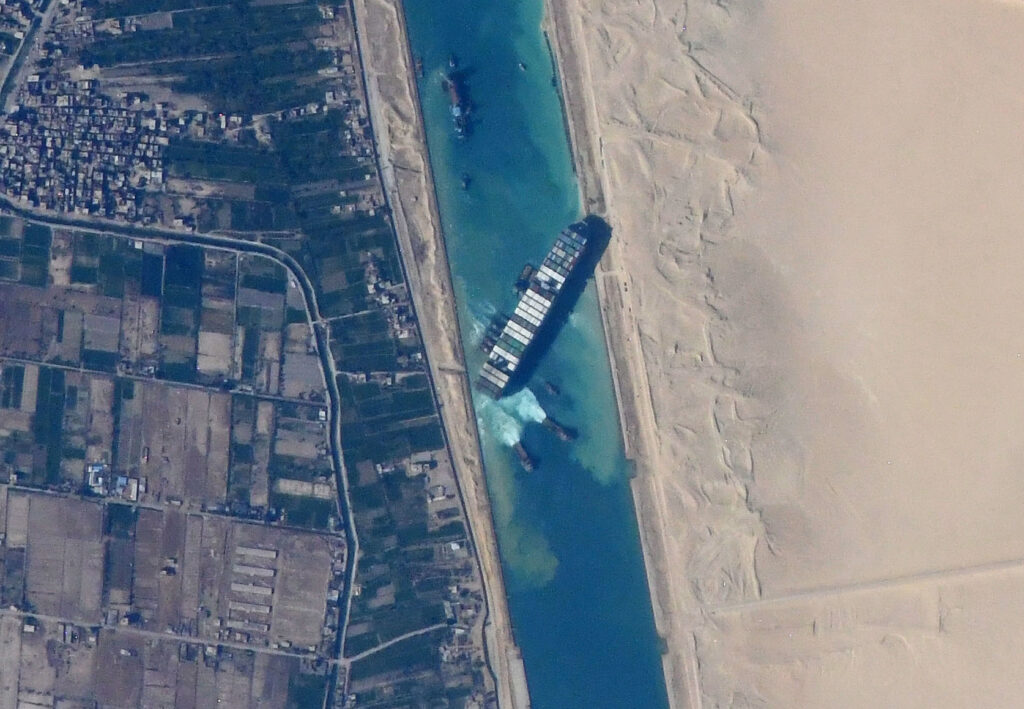
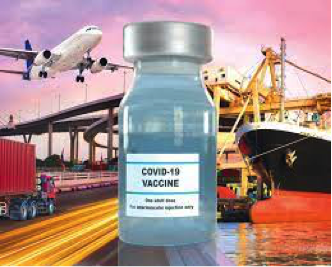
Source: Wikipedia MIckStephenson 1944
Source: Wiki. NASA JSC ISS image library
Source: CAAS 2020
5. Margin: As Bobby Locke, a legendary PGA golfer, said, “Drive for show and putt for dough.” Logistics plays a critical role in determining the final profit margin of a product, achieving time, cost, specification goals, and customer satisfaction.
6. Get Set: The key takeaway from these lessons is to be prepared. Setting up strategic logistics hubs is essential for dealing with the unexpected.
7.0 Management Team
7.1 Key Management Team
- Mentors: Visionary pioneers and industry leaders with a global network who provide guidance and inspiration.
- Coaches: Mission-oriented industry experts offering practical solutions to keep the team focused on its objectives.
- Partners:
- A project leadership group with visionary goals.
- A reputable investment manager with global cold chain logistics funding sources.
- Target market groups, including supermarket, meat, seafood, fruits, vegetables, food, pharmaceuticals, industrial chemicals, and beverage companies.
- Credible local logistics operators with procurement capabilities, local networks, solid financial status, and government support.
In the cold chain logistics industry, several global leaders have made significant contributions, shaping its growth and success. Here is a list of some of these remarkable individuals, honoured for their vision and dedication:
- Adam Forste
- Greg Lehmkuhl
- Martijn Lofvers
- Kevin Marchetti
- Sami Naffakh
- Matthew Ott
- Lieutenant General William Gus Pagonis
- Jordan Socaransky
These are just a few of the outstanding professionals and captains of the industry. The readers are encouraged to explore further and conduct their research to learn more about the management teams in this dynamic field.
7.2 Key Management Team Model
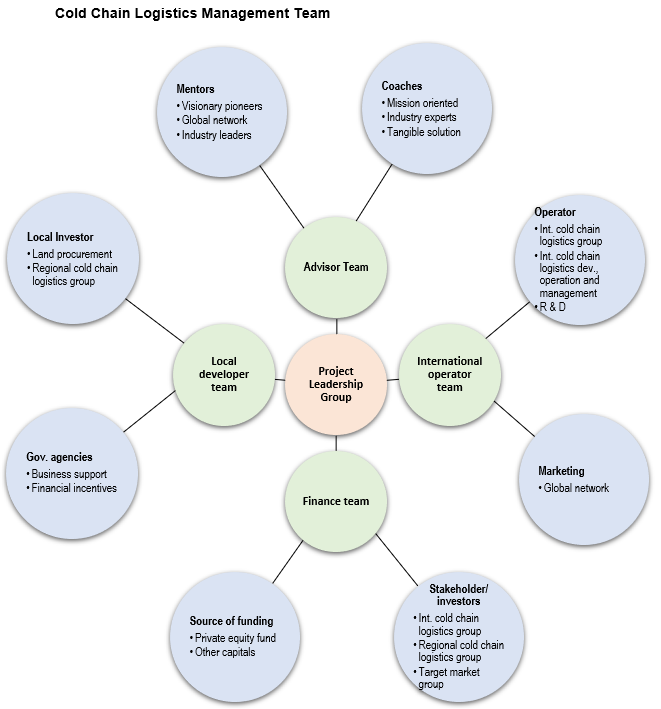
8.0 Unique Business Model
8.1 Successful Track Record
The management team and stakeholders bring a successful track record characterized by:
- Integrated solutions from origin to destination.
- Effective coordination with a central command.
- Extensive expertise in refrigeration, a global network, and deep product knowledge.
- Access to international cold storage facilities.
- Offering value-added services such as labeling, packaging, and comprehensive solutions.
- Reliability in services that customers can depend on.
- Collaboration with various chain stakeholders.
- Utilizing Remote Container Management and global monitoring programs.
- In-depth knowledge of local markets.
- Local expertise in market access and procurement support.
8.2 Entry model
Entry model options: scope of investment and services
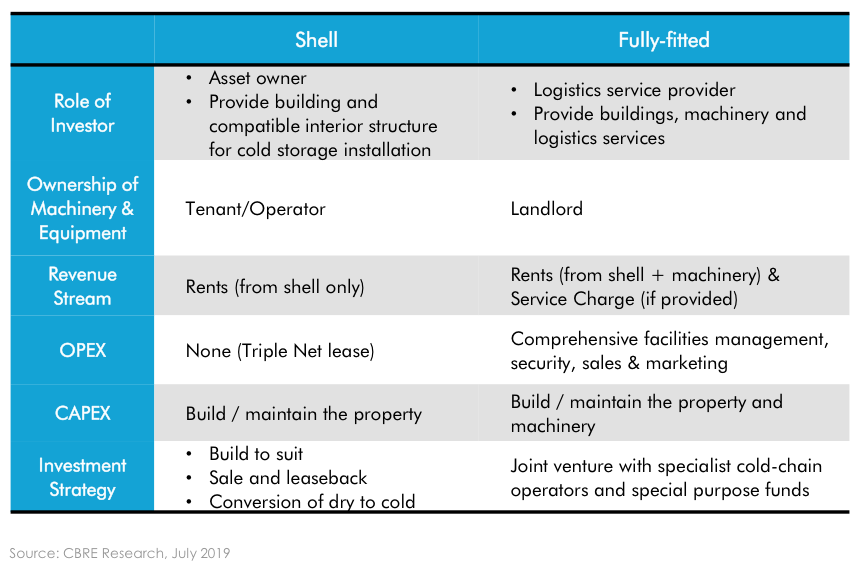
8.3 Unique Business Model
- A fully integrated vertical and horizontal business model that optimizes team specialization.
- Customer participation as the foundation for revenue and growth.
- Consideration of entry strategies such as purchasing or merging with local cold storage companies for rapid market penetration.
- Integration with existing importers, exporters, and distributors in specialized segments like food, fisheries, fruits, vegetables, meat, pharmaceuticals, and chemical products to expand market shares in the target segment.
9.0 Key Success Factors & Risk Mitigation
9.1 Key Success Factors
- Efficient Operations: Ensure efficiency in cold chain operations, from shipment preparation to last-mile delivery, by implementing a Quality Assurance Program (QAP).
- Integrity: Maintain transparency in processes, prevent theft and negligence, and foster continuous improvement through employee training, robust management controls, and regular audits.
- Technology: Utilize the expertise of team members to integrate the latest technology and equipment, enhancing the effectiveness of cold chain logistics.
- Scale: Establish strategic partnerships with major global cold chain logistics groups to access resources and achieve scalability.
- Standards: Attain international certifications like Certified Cold Carrier to uphold industry best practices and ensure high-quality operations.
Cold Carrier: industry-prescribed best practices program.
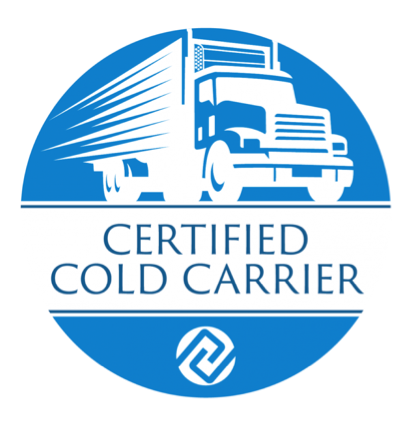
9.2 Risk
- Traceability: Administrative risks like inadequate record-keeping, lack of tracking data, and customs compliance issues.
- Delays: Risks include operational delays due to weather, human errors, equipment failures, and outdated tracking systems.
- Planning: Challenges from bureaucratic regulations and transportation mode errors.
- Power: Concerns regarding power surges and supply disruptions during transit.
- Packaging: Climate variations affecting packaging quality during transit.
- Control: Risks from inadequate temperature control, monitoring, and handling during loading/unloading.
9.3 Risk Mitigation
- Program: Implement advanced technology for robust traceability.
- Training: Develop staff skills, competency, and integrity through training.
- Digital: Regularly update equipment and digital tools to reduce delays.
- Plan B: Establish contingency plans, conduct regular reviews, and empower decision-makers.
- WHS: Enforce strict Work, Health, and Safety policies for staff and equipment safety.
- Automation: Enhance efficiency through automation.
- High-tech: Use temperature control, thorough documentation, proper packaging, and cold chain transport for effective risk mitigation.
10.0 Exit Strategy
10.1 Forms of Exit
- Exit options include IPO (Initial Public Offering), buy-out, M&A (Mergers and Acquisitions), and transfer.
10.2 Key Attractions for New Investors
- Portfolio: The cold chain logistics industry is experiencing growth, making it an attractive portfolio addition.
- Demand: Cold chain facilities offer essential services with limited competition, ensuring consistent demand.
- Barrier: High barriers to entry due to the complexity and high costs associated with the business.
- Cost: Potential for cost consolidation through new acquisitions.
- Growth: Opportunity to capitalize on the growth potential in emerging markets.